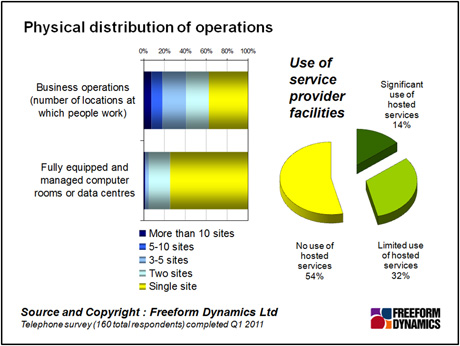Industry-standard x86 servers have now been used in SMBs for about 20 years, making this type of hardware one of the computing resources on which SMBs depend to function. Indeed, such systems have become so embedded in business processes that when they are not available many organisations may struggle to cope.
The development of effective virtualisation technologies is one of the major improvements in using servers to better support ever-expanding business requirements. These technologies have started to become more relevant to SMBs in terms of their price, performance and features. But how ready are SMBs to embrace virtualisation, and what impact will this have on the channel that sells and supports servers?

The chart to the left, taken from our recent survey of 160 SMBs in the UK, Germany and France, highlights that very few businesses have yet achieved much server virtualisation despite the fact that Windows-based x86 servers are widely deployed. As can be seen, more than half have not started virtualising to any significant degree, despite the advantages that virtualisation can offer in the areas of availability and resilience – to name but two of many potential benefits.
SMBs typically have few skilled IT staff, and those they do have tend to be IT generalists rather than specialists. Supporting many aspects of the company’s IT and focusing squarely on keeping systems running, they have little time to investigate how their organisations could benefit from new solutions.
Even when firms are aware of new offerings, it is clear that many are not automatically considered suitable for their own use, or even affordable – as IT vendors spend so much time marketing to large enterprises and so little communicating with SMBs.
Even as virtualisation technologies become embed-ded in servers as standard, small firms will need help to exploit them. Our research found that almost half of those surveyed did not expect their usage of x86 server virtualisation to increase in the coming years.
SMBs are likely to look to the resilience of their systems to enhance their capabilities, and this is an ideal chance for the channel to bundle a services offering based around virtualisation as an enabler. There are clearly opportunities here for the channel to package virtualised offerings and sell them to their clients. But such offerings must be marketed in terms that delineate their business value.
As we expected, we found that most SMBs operate from just one or two locations. An even larger proportion, nearly four out of five, have fully managed computer rooms or datacentres located at just one site. This poses challenges for firms seeking to enhance their disaster recovery capabilities in the event of a site failure or shutdown.

There is also plenty of scope to offer SMBs a range of hosted services because, once again, more than half currently make no use of such offerings. In fact, given the time constraints imposed on IT staff, it is unlikely that in-house IT staff would be able to take on any additional work. But organisations recognise that they have to improve their resilience to site failure.
This poses further challenges to the channel. Even when channel firms provide new services, additional work will be required to market and sell them. However, for SMBs to adopt managed services, their suppliers must address the pain points SMBs can recognise and, more importantly, for which they are willing to pay.
This makes regular interaction with the channel’s client base more important than ever, to establish what solutions are likely to make for sales success. Few offerings are ready straight off the shelf to address business issues around IT resilience. In most cases, significant advice and services will be needed – and these are the areas where the channel lives and breathes.
And remember – most SMBs are more comfortable dealing with a local supplier than a web site or phone salesperson – especially for business-critical matters.
CLICK HERE TO VIEW ORIGINAL PUBLISHED ON

Through our research and insights, we help bridge the gap between technology buyers and sellers.





Have You Read This?
From Barcode Scanning to Smart Data Capture
Beyond the Barcode: Smart Data Capture
The Evolving Role of Converged Infrastructure in Modern IT
Evaluating the Potential of Hyper-Converged Storage
Kubernetes as an enterprise multi-cloud enabler
A CX perspective on the Contact Centre
Automation of SAP Master Data Management
Tackling the software skills crunch